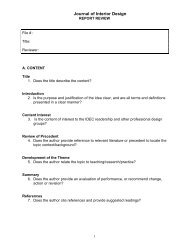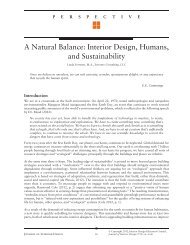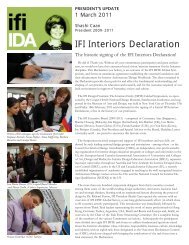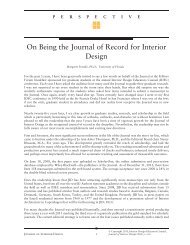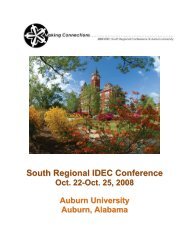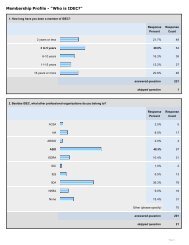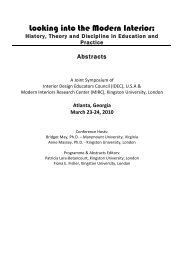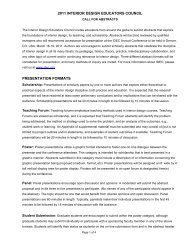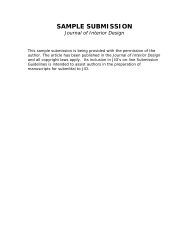2002 Conference Proceedings - Interior Design Educators Council
2002 Conference Proceedings - Interior Design Educators Council
2002 Conference Proceedings - Interior Design Educators Council
Create successful ePaper yourself
Turn your PDF publications into a flip-book with our unique Google optimized e-Paper software.
SummaryOur initial results provide some interesting insights on the use of virtual environments tostudy people's preferences for assisted living. Subjects may have had a difficult timeimagining themselves to be frail and living in the assisted living environment wheremeals are served in dining halls because most wanted the model with the large kitchenso they could prepare meals. The second most often desired larger space was for theliving or social area. Many commented on the small size of the apartment as comparedto what they perceived to be normal. A surprisingly large number commented on thelack of a computer or space for a computer. Many of the participants kept in contact withfamily or friends through the Internet so this has become an important communicationtool for older adults. However, because of the large number of retired professors in thesample, computer users may have been a higher percentage than what has been foundin the general population (Department of Commerce, 2000). Others commented on theprovision of only one window and wished that the apartment had more natural light.These comments indicate the subjects were able to perceive the assisted living space infull scope and close to what might be termed reality. Thus, these subjects were able togive feedback on the apartment design with the use of virtual environments or theCAVE.These results suggest that designers can use their creativity and skills to create assistedliving private living spaces that meet the needs of the older adults. Several techniquescould be used to make the small size of the apartment appear larger such as using anopen plan, smaller scale furniture, or light colors. Another feature might to designstorage cabinets and closets that are integrated into the space so that the space willappear larger rather than when you have a separate room for storage. Finally, designingflexible spaces that address residents' differing lifestyles and usage of electronic mediais recommended based on the results of this research.Some futuristic designs for assisted living private spaces will be presented to givedesigners insights on how the findings of this research could be used in practice.These designs might be similar to those used in the future.ReferencesDepartment of Commerce, (2000). Falling through the net: A Report on Americans'Access to Technology Tools. Online: http://www.esa.doc.gov/fttn00.htm.Lindsey, P. & McLain-Kark, J. (1998). A comparison of real world and virtual worldinterior environments. Journal of <strong>Interior</strong> <strong>Design</strong>, 24(1), 27-39.McLain-Kark, J. & Lee, J. (1998). Using the CAVE as a design evaluation tool.<strong>Proceedings</strong> of the DCNet98. University of Sydney, Sydney, Australia, December1, 1998.National Center for Supercomputing Applications, (1998). The CAVE at NCSA.Online: http://www.ncsa.uiuc.edu/VEG/ncsaCAVE.htmlTinsley, R. K., & Warren, K. E. (1999). Assisted living: The current state of affairs. InSchwarz, B., & Brent, R. S., (eds.). Aging, autonomy, and Architecture: Advancesin Assisted Living. Baltimore: The John Hopkins University Press.33





